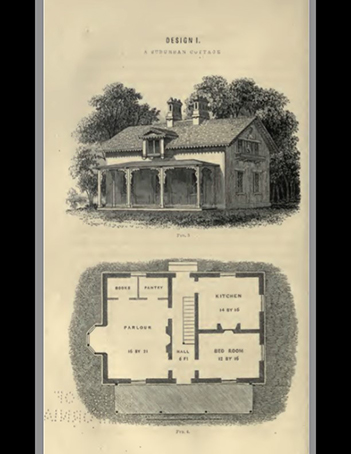
24 Jan 2019 The Remarkable History of 197 Green Street – Part I
Jenny Nathans is a public health professional, a burgeoning preservationist and a resident of Jamaica Plain. She recently published a version of this research on the historic house at 197 Green Street in Jamaica Plain for the Jamaica Plain Historical Society. Nathans tells the fascinating story of the neighborhood’s 19th century growth and suburbanization through a focus on one historic house – now threatened with demolition — around which the 20th and 21st century neighborhood has evolved. We are grateful to Jenny for adapting her research for HBI’s blog in two parts.
The story of the house at 197 Green Street is an integral part of the history of Jamaica Plain. The house appears to be our only remaining connection to the area’s first development as a suburb and home for middle-class tradesmen – after the time of farms and country estates, but before the introduction of multi-family dwellings and major business and industry along Green Street. The house illustrates both the rural ideal of the time period and the origins of the residential construction we continue to see today.
As reported in local media outlets, real estate developer City Realty Group is currently awaiting approval from the City of Boston to demolish the now-vacant house and build a four-story, mixed-use development.
In the 18th century, Jamaica Plain was a rural village in the Town of Roxbury. In addition to farmland and small-scale industry that developed along Jamaica Pond and the Stony Brook, the neighborhood attracted a population of wealthy families who built their country estates amongst its wooded hills.

Downing’s Pattern for “A Suburban Cottage for a Small Family” Source: Downing, A. J. (1842) Cottage Residences; or a Series of Designs for Rural Cottages and Cottage-Villas, and their Gardens and Grounds: Adapted to North America. New York: Wiley and Putnam
The Boston and Providence Railroad lines extended into the neighborhood in 1834, followed by the horse-car trolley in 1856, and the electric streetcar service in 1889. At the same time, popular publications promoted the health and moral benefits of living in the country. The availability of public transportation and a desire for a rural lifestyle led many in the middle-class to escape the crowded and dirty city of Boston at the end of the work day for a home in the Jamaica Plain countryside, transforming the neighborhood into a “streetcar suburb” for middle-class commuters.
This new commuter class drove a demand for housing. The large estates were soon split up into lots and sold off to developers and homeowners, including the estates along Green Street. Multiple houses were now being built on land where once only a single family had lived. As Elaine Stiles explains in her 2001 article History of the Development of Green St. 1836-1900, in addition to serving the needs of commuters, the lots on Green Street also provided land on which to build homes for middle-class residents who lived and worked locally.
The house at 197 Green Street was very likely one of these early homes. Based on historical plans and maps, and the architecture of the house, it was probably built sometime between 1854 and 1858. As we will see in Part II, this would place the construction of the house immediately after the initial subdivision of the eastern end of Green Street, but before the area saw a rapid increase in population and industry brought on by electric streetcar service.
As Stiles states, by 1885, commercial development on Green Street took over most of the land on the eastern side of the railroad. The type of housing along the street changed as well. “Multi-family dwellings made up nearly half of all residential property on Green Street in 1898 whereas in 1874, there were only two multi-family dwellings on the entire street (Stiles, 2001).” This change in housing was a response to a tenfold increase in population between 1850 and 1900.
In Part II, we will take a deep dive into the origins of the historic structure at 197 Green Street, and by extension, the history of the neighborhood.



